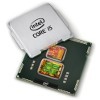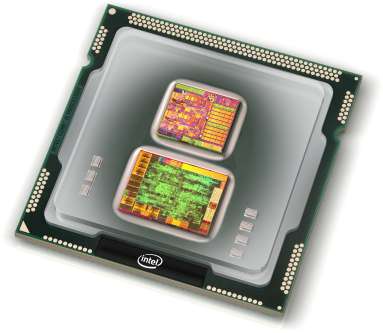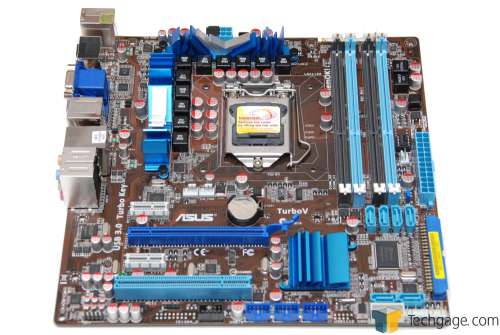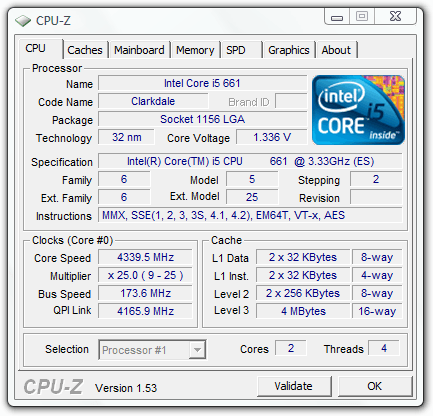- Qualcomm Launches Snapdragon 4 Gen 2 Mobile Platform
- AMD Launches Ryzen PRO 7000 Series Mobile & Desktop Platform
- Intel Launches Sleek Single-Slot Arc Pro A60 Workstation Graphics Card
- NVIDIA Announces Latest Ada Lovelace Additions: GeForce RTX 4060 Ti & RTX 4060
- Maxon Redshift With AMD Radeon GPU Rendering Support Now Available
Overclocking Intel’s Core i5-661

Purchasing a new CPU today that doesn’t overclock well just doesn’t happen, and Intel’s Clarkdales don’t change a thing. As a dual-core, these new models are even easier to overclock than the quads, making the OC’ing appeal even greater. We’re taking a look at overclocking the Core i5-661, focusing on both the CPU and GPU.
Page 1 – Introduction
To preface this article, I’d like to recommend checking out our in-depth look at Intel’s latest microarchitecture, Clarkdale, which was posted earlier this week. Nehalem for everyone is finally here, and it’s about time. So far, Westmere has given us only dual-core models, but all feature HyperThreading, so while it may not be a quad-core, you’re still getting that huge multi-threading ability. In our tests, Westmere, and Clarkdale specifically, proved much faster than the previous generation in a lot of ways, especially when the AES-NI instruction set is brought into things.
No matter how inexpensive or expensive, exciting or boring a processor may be, one surefire way to excite the senses is by taking your brand new toy and overclocking the heck out of it. It used to be that overclocking was left to those who didn’t mind risking their components, or genuinely needed a speed boost, but today, I feel like that mentality has changed a little. Both AMD and Intel are delivering processors that almost beg to be overclocked, and in some cases, even a 25% or higher frequency boost ends up being stable on an air cooler… that’s impressive.
Just because you can do something, though, it doesn’t mean you should. Here, though, more and more people are pushing their processors harder than ever, from doing simple tasks like photo editing to more complex tasks such as video editing. The fact is, an overclocked processor will take care of these processes faster. One example I like to fall back on is 3D rendering. If you have a project that takes 5 hours to render, then a 25% overclock could render it in almost 1/4th of the time. This varies from application to application, but for the most part, if you do anything on your PC that takes minutes, tens of minutes, hours, or even longer to execute, overclocking can prove hugely beneficial.

With Westmere, not too much changes on the overclocking front. If you’re familiar at all with how Lynnfield is overclocked, then Westmere is pretty much no different. You have to worry about the BCLK (Base Clock), along with the CPU ratio. Most often, you won’t even have to touch the voltages yourself, unless you want to go really high. For us here, though, I’m more interested in finding a stable overclock won’t result in raising your room temperatures by 15°F or so. For this article, like our previous overclocking-focused articles, I’ll be using a regular air cooler for all benchmarking, which in this case is Thermalright’s MUX-120. This cooler is a bit more expensive than the competition, but it’s as good as they come for the LGA1156 platform.
Overclocking the CPU may not involve a far different process than what we’re used to, but another factor at play is of course the integrated GPU (IGP). Fortunately, Intel made it so that overclocking the CPU has no effect whatsoever on the GPU, and both use their own voltages and can be overclocked in the motherboard BIOS, should the vendor provide the support. In the case of our P7H55D-M EVO board from ASUS, the feature was there, so we took advantage of it and overclocked both the CPU and GPU.
Overclocking the CPU
As just mentioned, our test board is ASUS’ P7H55D-M EVO, one of the company’s mainstream offerings that’s likely to cost around ~$130 when it hits the store shelves (this is an estimate, I have no clue whatsoever, I just can’t imagine a mainstream mATX board being much higher). This was the board that I used throughout almost all of my Clarkdale testing, and after all my experience, I can say that it’s absolute quality. The robust feature-set and tweaking-ability that’s found on ASUS’ desktop boards is found here, and when using it, it certainly doesn’t feel scaled down in any way, and that’s about to be proven in a minute with our impressive stable overclock.
Like the model name suggests, this board uses Intel’s H55 chipset, which means the only “major” feature it’s lacking is AHCI. This is seemingly beyond ASUS’ control, and it seems that it’s a feature that will be completely limited to H57 motherboards. To be fair, though, AHCI isn’t entirely important for most people, but enthusiasts may wish to upgrade to H57 for the sake of adding it in (the difference in chipset price is $3, with the H57 model also including 2 additional USB ports and PCI-E lanes).
Before jumping into our overclocking results, you can quickly review our test machine specifications if you wish:
|
Component
|
Intel LGA1156 (Westmere) Test System
|
| Processor | Intel Core i5-661 – Dual-Core, 3.33GHz, ~1.10v |
| Motherboard |
ASUS P7H55D-M EVO – H55-based, 0503 BIOS (12/02/09)
|
| Memory |
Corsair XMS3 DHX 2x2GB – DDR3-1333 7-7-7-20-2T, 1.65v |
| Graphics |
ATI Radeon HD 4870 512MB (Catalyst 8.11)
|
| Audio |
On-Board Audio
|
| Storage | |
| Power Supply | |
| Chassis | |
| Display | |
| Cooling |
Thermalright MUX-120
|
| Et cetera |
The great thing about overclocking any recent Intel processor is that it’s easy… so easy in fact, that you rarely even have to manually adjust the voltage levels. This to a degree depends on the motherboard you’re using as well, because it needs to be designed in such a way that it will scale the voltages when clocks go higher. Our ASUS board is a perfect example of one that handles that process fine, so I didn’t have to touch any voltage level at any time during testing… it handled it on its own.
Using our robust air cooler, I found the max stable overclock on our processor sample to be around 4.33GHz, which was achieved with a base clock of 173MHz:
You can click that image to see our LinX run, and also check out our Cinebench screenshot which somewhat acts as a secondary method of stability. I have little doubt that the CPU could be pushed even further, but it was at this point that I felt completely confident in our achievement. I tried to go a bit higher, at around the 176MHz mark, but it would spawn errors with LinX. It’s not that surprising, since 3MHz with a 25x multiplier equals 75MHz… not exactly an insignificant difference.
One thing I would like to stress is that our overclock here is what I found to be the best possible on our particular setup. Your setup, especially the processor, may allow a higher, or lower, top overclock. If there’s one thing I can jump to conclusions on, it’s that hitting 4GHz on this CPU is easy. It may not be if you are using a lower-quality motherboard, but even then… it’s very easy to hit 160MHz BLCK on most any motherboard out there. As seen in the screenshot, our CPU voltage didn’t even have to be very high to achieve such a great clock… a mere 1.33v.
Overclocks would be useless if they didn’t give us improved performance, so just how much of a boost did our clock give us throughout our fleet of tests?
|
Intel Core i5-661 3.33GHz (Overclock: 4.33GHz)
|
|||
|
Benchmark
|
Stock
|
Overclock
|
Increase
|
| Autodesk 3ds Max 2009 Dog Render Bathroom Render |
250s
739 s |
203s
587 s |
18.8%
20.6% |
| Cinebench R10 Single-Thread Multi-Thread |
4668
10851 |
5908
13587 |
26.56%
25.21% |
| POV-Ray 3.7 Single-Thread Multi-Thread |
857.2
2157.65 |
1083.49
2841.76 |
26.39%
31.70% |
| Adobe Lightroom 2.0 Convert 100 RAW to JPEG |
132.44s
|
115.001s
|
13.2%
|
| TMPGEnc Xpress HD Video Encode Mobile Video Encode |
266s 133s |
213s 104s |
19.93% 21.89% |
| ProShow Gold HD Video Encode DVD Video Encode |
458 s 112s |
393 s 93s |
14.2% 16.97% |
| Sandra Arithmetic Dhrystone SSE4.2 Whetstone SSE3 |
33130 MIPS 51050 MFLOPS |
41400 MIPS 63870 MFLOPS |
24.96% 25.11% |
| Sandra Cryptography AES256 SHA256 |
3520 452 |
3320 566 |
-5.69% 25.22% |
| Microsoft Excel Monte Carlo Big Number Crunch |
27.411 s 8.066 s |
22.561 s 6.567 s |
17.7% 18.59% |
No surprise, some of the gains were quite significant. Not all scaled quite exactly with the gains of our clock speed, but no single test here was unimpressive. Well, except for our AES test in Sandra, which proved quite interesting. For some reason, our results there were lower when overclocked, and this proved consistent. It’s as though the section of the chip that handles the AES instruction set just doesn’t react well to increased voltage or clock speeds. You’ll notice we did see an increase with our SHA test just fine. I went back and forth from stock to overclocked speeds, and the results kept flip-flopping. Very strange result, to say the least.
Even with the decrease in that one test, it’s still about 12x faster than what the 3.33GHz Core 2 E8600 could muster, so it’s hardly an issue. Unless of course, all you’re doing on your PC is taking advantage of various scenarios that use AES quite heavily. In the consumer space, I’d be quite doubtful of that.
With our CPU overclocking and tests taken care of, let’s move into a look at overclocking the integrated graphics.
Support our efforts! With ad revenue at an all-time low for written websites, we're relying more than ever on reader support to help us continue putting so much effort into this type of content. You can support us by becoming a Patron, or by using our Amazon shopping affiliate links listed through our articles. Thanks for your support!







